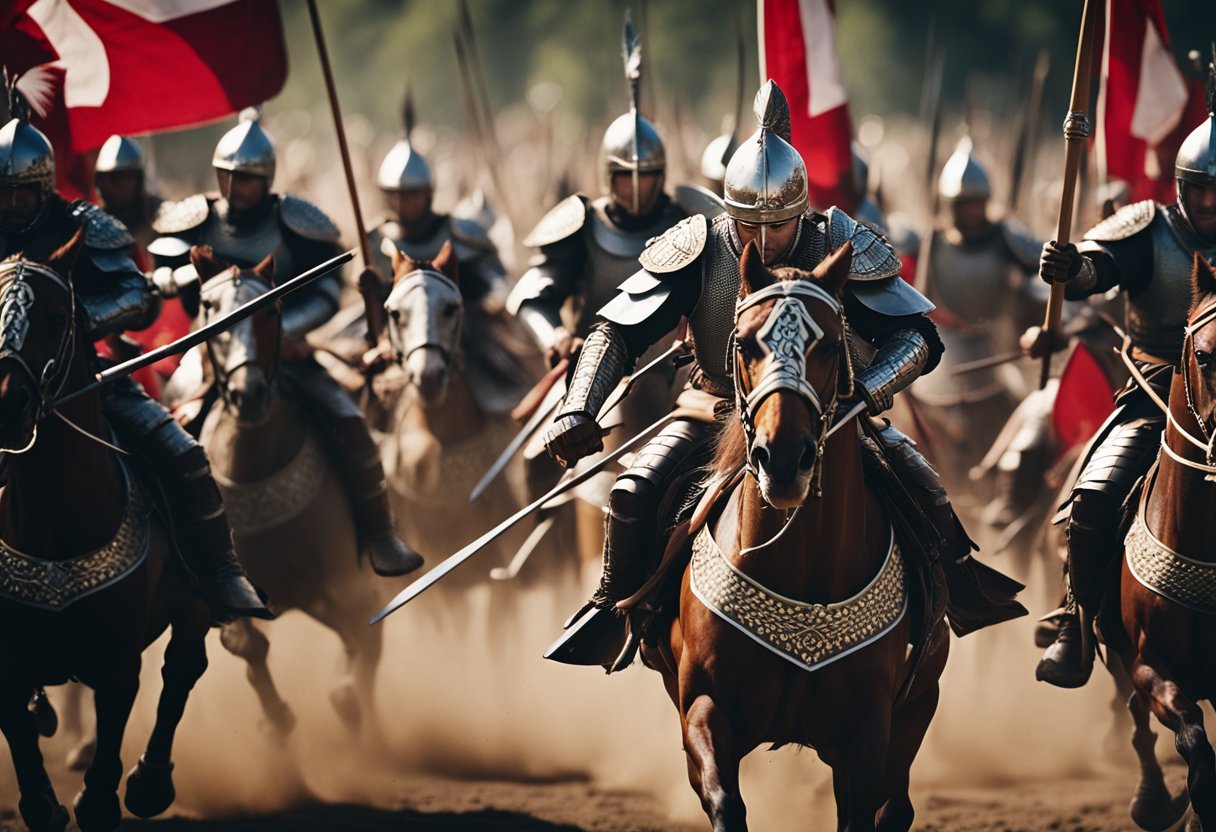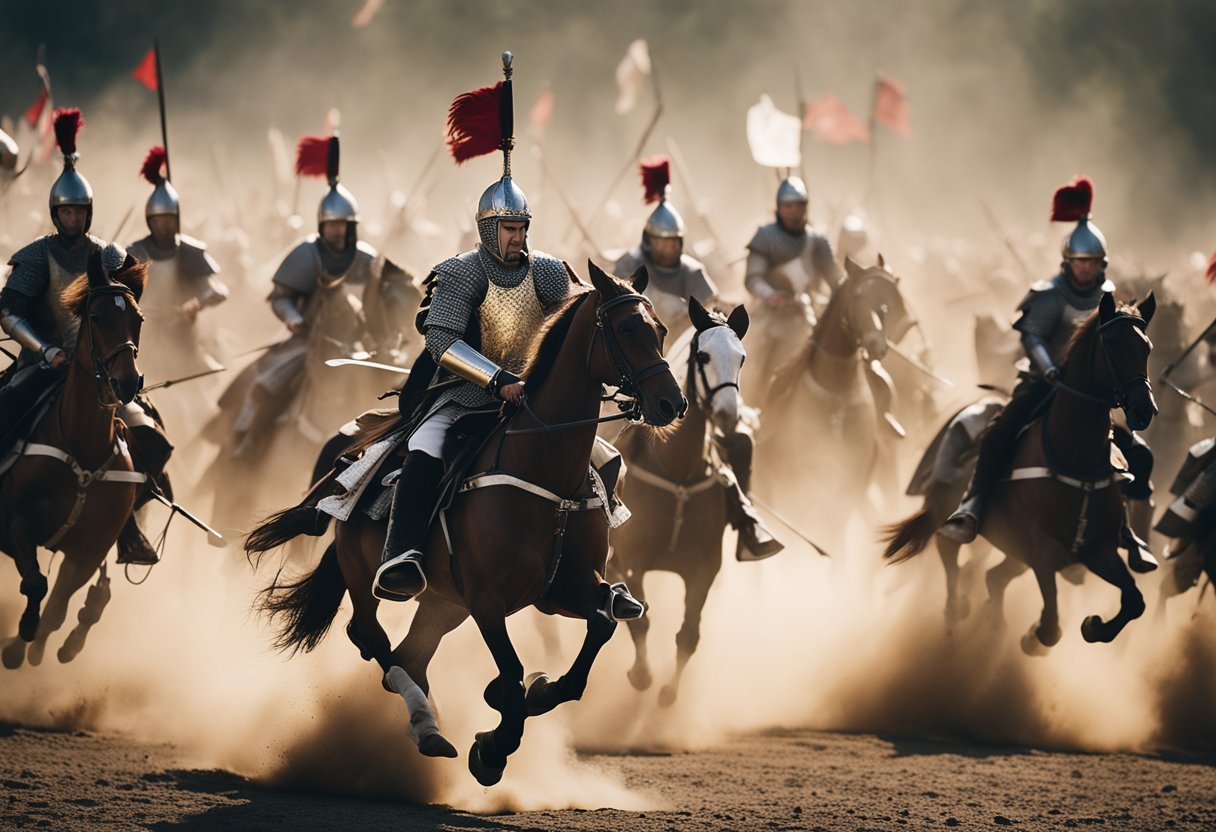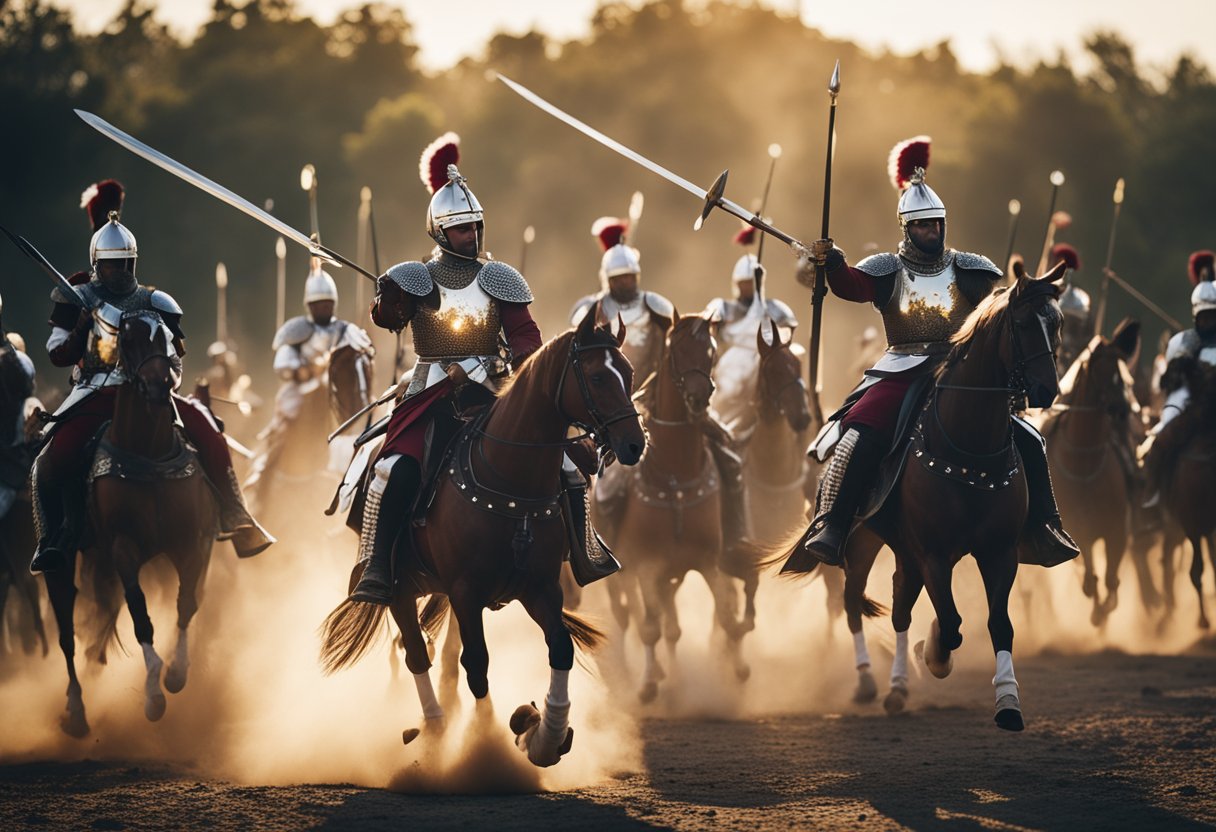The Polish Winged Hussars: Unveiling the History and Legends of Europe’s Formidable Cavalry

Updated On: April 15, 2024 by Marwa Alaa
The Polish Winged Hussars represent one of the most visually striking and effective cavalry forces in European history. Emerging in the late 16th century, these elite horsemen served as the core of the Polish-Lithuanian Commonwealth’s military might and became celebrated for their flamboyant appearance, distinctive equipment, and daring combat tactics. Their battlefield prowess was a result of rigorous training and the use of heavy armour and weaponry, which allowed them to strike with devastating impact.

Known for their iconic winged back attachments and lavishly decorated armour, the Winged Hussars became not just military units but symbols of power and nobility. Their role in significant military engagements underscores their importance in shaping the geopolitical landscape of Europe. The Hussars’ legacy extends beyond their military success, influencing cultural depictions, patriotic sentiments, and historical studies, which continue to capture the imagination of people around the world.
The Emergence of the Polish Winged Hussars in Europe
As we explore the storied past of Europe’s cavalry, our focus narrows to the hussars’ genesis, particularly their evolution in Poland into the renowned winged hussars.
Origins and Early History
The term ‘hussar’ finds its roots possibly in the Serbian word “gusar”, which means “wanderer” or “brawler”. Initially, the hussars were a light cavalry used by various European armies. By the 15th century, they had become integral to the warfare tactics across the continent. Their primary role was that of fast, mobile units which performed tasks such as reconnaissance and skirmishing.
Poland’s Adoption and Transformation into Winged Hussars
Poland’s impactful chapter in hussar history began in the early 16th century when exiled Balkan fighters were organised into mercenary groups. Subsequently, in 1503, Poland’s parliament formed the first official hussar units, marking their transition from mercenaries to a significant component of Poland’s military forces. Notably, this transformation also saw the light cavalry morph into heavy shock cavalry. The distinctive wings attached to their backs and the ornate, gilded armour they adorned contributed to the creation of an enduring legend—the Polish winged hussars. They amassed a fearsome reputation for their role in numerous conflicts, defending Poland and influencing warfare across Europe.
Characteristics of the Winged Hussars
The Winged Hussars were renowned for their impressive armour and weaponry, along with their iconic wings, which gave them a formidable presence on the battlefield. Their horses played a crucial role, complementing the Hussars’ tactics and effectiveness.
Iconic Wings and Their Purpose
The wings of the Winged Hussars are perhaps their most distinguishing feature. Made of wood, feathers, or metal, these wings were fastened onto the back of the armour or directly to the saddle. Theories about their purpose vary; some suggest that the wings were intended to create an intimidating noise when the Hussars charged, while others propose that they were designed to protect against lasso attacks by deflecting the ropes.
Armour and Weapons
Equipped with armour that was designed to be both protective and visually striking, the Winged Hussars wore a helmet typically adorned with exotic bird feathers or leopard skin. Their armour included a metal cuirass, arm bracers, and greaves to cover the legs, ensuring a combination of defence and mobility. The primary weaponry was the lance, which the Hussars used with deadly effect in charges. In close combat, they wielded a sabre.
Armour components:
- Cuirass
- Arm bracers
- Greaves
- Helmet
Weapons:
- Lance
- Sabre
- Often accompanied by a shield or a secondary firearm.
Horses and Their Role
Our horses were not mere mounts; they were integral to the Winged Hussars’ tactical approach. These steeds were strong and fast, trained to manoeuvre swiftly in battle, which maximised the impact of a charge. The horses wore protective barding that matched the Hussar’s own ensemble, and their role in the Hussars’ shock tactics cannot be overstated.
Horse characteristics:
- Strength
- Speed
- Training for battle manoeuvres
Barding components:
- Chamfron (Headpiece)
- Crinet (Neckpiece)
- Flank armour
Battle Tactics and Strategies
Our focus here is to illuminate the meticulous battle formations and combat techniques that positioned the Polish Winged Hussars as a formidable force in military history. Drawing on their structured tactics and legendary prowess, we’ll understand how they earned their place as Europe’s striking cavalry.
The Hussars’ Battle Formation
The core of the Hussars’ military strength lay in their well-organised battle formations. Often, they initiated attacks with a heavy cavalry charge designed to break through enemy lines and cause disarray. Forming up in a wedge shape—a tactic known as the ‘kleszcze’ or pincers—they could concentrate their force on a specific point, thereby maximising the impact of their charge.
Notable Combat Techniques
Key to the Hussars’ success were their notable combat techniques, which included the renowned cavalry charge. As the charge commenced, the pace would gradually increase until they reached full speed, projecting an impenetrable force upon enemy troops. This not only served as a powerful physical onslaught but also as a kind of psychological warfare, deeply intimidating the opposing forces. Hussars were highly skilled in wielding long lances, which they used with deadly precision to dismantle enemy defences.
Throughout numerous battles, such as the legendary encounter at Kircholm, the Winged Hussars proved their mastery of tactical warfare, often engaging larger enemy formations to their detriment. By adopting strategic manoeuvres encompassing speed, shock, and psychological intimidation, they were able to claim victories even when the odds were stacked against them.
Distinguished Battles and Victories
The Polish Winged Hussars, with their distinctive wings and fearless combat style, played a pivotal role in many battles across Europe. They achieved several remarkable victories from the late 16th to the early 18th century, demonstrating their military prowess against various adversaries.
Battle of Vienna
In 1683, the Battle of Vienna marked a significant triumph for the Polish Winged Hussars. As the forces of the Ottoman Empire laid siege to Vienna, the hussars, led by King John III Sobieski, launched a decisive cavalry charge that ultimately broke the siege and pushed back the Ottoman troops. This engagement not only showcased the hussars’ valour but also helped to establish a strategic alliance among Christian nations.
Battle of Kircholm
The Battle of Kircholm fought on 27 September 1605, was a stunning achievement where the hussars, under the command of Hetman Jan Karol Chodkiewicz, overcame the Swedish army. Despite being heavily outnumbered, the Polish-Lithuanian forces, bolstered by their hussar regiments, inflicted a crushing defeat on the Swedes, setting a precedent for their strategic capabilities in warfare.
Other Notable Engagements
Beyond these famed confrontations, the Winged Hussars were instrumental in many other notable engagements. They played key roles in battles against diverse foes, such as the Tatars and other members of the Ottoman Empire. Their battlefield contributions were marked by innovation in tactics and an indomitable spirit, which often led to victories even when facing numerically superior enemies.
The Winged Hussars’ Legacy
The Winged Hussars have left an indelible mark on both military history and cultural heritage. Our exploration takes us through their contribution to European martial tactics and their enduring presence in modern culture.
Influence on European Military Practices
The impact of the Polish hussars on European military strategies is well-documented by historians. Known for their distinctive wings and exceptional combat skills, they influenced the art of warfare significantly within the European theatre. The seismic Battle of Chocim is but one instance where their prowess turned the tide, showcasing tactics that were later studied and emulated. The heavy cavalry’s use of long lances, for example, became a staple among various European armies.
Cultural Impact and Modern Remembrance
Culturally, the legacy of the hussars resonates through the ages. The image of the hussar has become a symbol of pride and martial excellence within the Commonwealth, enduring in the minds of Hussar enthusiasts and reenactors. We find an example in Luke Szczygielski, a prominent figure among reenactors, who dedicates his efforts to bringing the rich history of the hussars to life. Additionally, experts like Dr. Radosław Sikora provide scholarly insights that illuminate our understanding of the hussars’ cultural significance. This fascination with the hussars continues to influence literature, film, and festivals, ensuring that their storied past remains a vibrant part of our historical consciousness.
The Armoury and Equipment
The Polish Winged Hussars, renowned for their impressive and highly effective military gear, utilised an array of armoury that evolved significantly from their inception as light cavalry to becoming the legendary heavy cavalry of Europe.
Heavy vs Light Cavalry Gear
Initially, the Hussars were akin to light cavalry, equipped for speed and manoeuvrability. Their armour was lighter, allowing for rapid movements during reconnaissance and hit-and-run tactics. As light cavalry, their defensive gear consisted mainly of a small shield and helmet, whilst their offensive arsenal included lighter, shorter swords and firearms suited for swift skirmishes. However, with the changing demands of warfare, the Hussars transitioned into heavy cavalry. This change came with a distinctive enhancement to their gear – they adopted heavier and more protective plate armour, which included a breastplate, backplate, and armour for the limbs, capable of absorbing the impact of enemy blows. Their helmets became more robust, often featuring a winged design that contributed to their fearsome appearance.
Evolution of the Hussars’ Armament
Over time, the Hussars’ armament underwent a profound transformation, keeping pace with the advancements in military technology and strategy. They began to carry pistols and heavier firearms, which were a significant departure from their previous reliance on lighter weapons. The swords used by the Hussars evolved as well; The sabre, particularly the legendary szabla, became the characteristic weapon of the Winged Hussars. The combination of armour and weaponry not only provided superior protection but also turned the Hussars into an imposing force on the battlefield. This blend of heavy and offensive armament cemented their reputation as an invincible cavalry capable of breaking enemy lines with their menacing charge and sustained combat presence.
Iconography and Symbolism

The Polish Winged Hussars are not only renowned for their prowess in battle but also for their striking visual flair, which has been immortalised in art and media and carries deep symbolic meaning through its iconic feathers and wings.
Visual Representation in Art and Media
The Winged Hussars have been depicted by numerous artists, capturing the splendour and detail of their ornate armour. These portrayals often emphasise the appearance of the hussars, particularly focusing on their feathers and wings, which were arguably their most distinctive features. Whether in historical paintings or modern documentaries, the Winged Hussars are consistently represented with their wings, which lends an air of fearlessness and audacious spirit that has captivated audiences for centuries.
Symbolic Value of the Wings and Feathers
The wings and feathers of the Polish Hussars hold significant symbolic value. Traditionally, eagle feathers were used, highlighting the connection to courage and the sovereign sky. In the context of battle, the wings created an imposing silhouette that, beyond pure aesthetics, played a psychological role in inciting fearlessness in allies and doubt in adversaries. This symbolism of the wings, representing the pride and unyielding spirit of the hussars, remains deeply ingrained in the memory of European cavalry history.
Winged Hussars in the Polish-Lithuanian Commonwealth
The Winged Hussars represented the pinnacle of the cavalry within the Polish-Litharian Commonwealth, renowned for their socio-political influence and vital role in the defense of their homeland.
Socio-political Status of the Hussars
The Polish Winged Hussars were an esteemed military unit drawn primarily from the nobility of the Commonwealth. They enjoyed a prestigious status and were often landowners with significant influence in the political realm. Known as the Husaria, their reputation for valour and skill both enhanced their social standing and reinforced their elite position within the army. Their equipment, adorned with the iconic wings that became synonymous with their name, was financed through their own affluent means, showcasing their wealth and commitment to the Commonwealth’s military prowess.
Role in the Defence of the Commonwealth
During times of conflict, the Husaria were instrumental in the defence of the Polish-Lithuanian Commonwealth. Their legendary charges into battle were significant in repelling invaders and securing pivotal victories. One notable instance of their martial skill was at the Battle of Kircholm in 1605, where the Hussars, heavily outnumbered, managed a decisive triumph against Swedish forces. Their role was not only crucial on the battlefield; it also emboldened the heart and spirit of the Commonwealth, creating a legacy that intertwined with the identity of the Polish Republic itself.
Transformation and Disbandment

As the tides of warfare evolved, so too did the fate of the Polish-winged Hussars. Once the unrivalled force of Europe, changing times and military innovations signalled their decline and eventual disbandment.
Factors Leading to the Decline
Economic Hardship: The lavish cost of maintaining the hussars became a significant burden. Each hussar was responsible for their own equipment, and as noble wealth waned, so did the ability to field such an expensive unit.
Military Innovations: The advent of new military technologies, particularly the increased use of firearms, lessened the effectiveness of cavalry charges. Hussar tactics centred on shock and awe, were rendered less effective in the face of organised infantry and artillery fire.
The End of the Winged Hussars Era
Reform and Reorganisation: By the 18th century, the need for greater flexibility on the battlefield led to a rethinking of cavalry roles. The traditional tactics of the Winged Hussars were outpaced by lighter and more versatile forces.
Official Disbandment: The significance of the hussars waned until their official disbandment in the late 18th century, marking the end of an era for Poland’s storied cavalry. Their legacy, however, continues to captivate and endure in our history.
Historical Reflections and Modern Perceptions
In this section, we’ll explore how academic research interprets the hussars’ impact on history and their continued cultural significance today.
Academic Studies and Interpretations
Historians have meticulously analysed the legacy of the Polish Winged Hussars, with a rich trove of academic literature underpinning their formidable reputation. Polish historians play a pivotal role in uncovering the nuanced truths of these cavalrymen, often challenging long-held myths to present a balanced view. Archival work and battlefield archaeology contribute to a more comprehensive understanding, revealing tactics and strategies that set the hussars apart as a military force.
Scholarly discourse often revolves around the transformative effects the hussars had on European warfare, from their dominating presence in the 16th to the 18th century to their eventual decline. The consensus among academics is not only of universal admiration for their martial prowess but also a fascination with how such a unit evolved and functioned within the Polish-Lithuanian Commonwealth.
The Winged Hussars in Popular Culture
In modern times, the image of the Polish Winged Hussars has transcended mere historical study, becoming an iconic figure in popular culture. Depictions in films, literature, and music frequently embellish the hussars’ appearances and deeds, sometimes bordering on the mythical. Such representations have galvanised a community of enthusiasts and reenactors eager to bring the hussars’ storied past to life.
The striking visuals have made the Winged Hussars a favourite among artists, inspiring dramatic portrayals that echo through various forms of media. From epic poems to heavy metal anthems, they are celebrated for their valour and resilience. The enduring fascination is perhaps best encapsulated by the multitude of festivals and reenactments, where the hussars’ legacy continues to resonate with both young and old.
Frequently Asked Questions
In this section, we explore some of the most commonly asked questions about the legendary Polish Winged Hussars, their unique characteristics, and their role in military history.
Why were the winged hussars distinguished by their unique wings?
The unique wings of the Polish Winged Hussars served both practical and psychological purposes. They created an intimidating noise when the hussars charged, which could unsettle enemy horses and infantry. Additionally, they contributed to the hussars’ striking appearance, bolstering their reputation on the battlefield.
What factors contributed to the effectiveness of the winged hussars in battle?
The effectiveness of the winged hussars in battle was due to their rigorous training, heavy armour, and the use of shock tactics. Their exceptional skills and the heavy lances they wielded allowed them to break enemy lines with their powerful charges.
In what battles did the winged hussars play a pivotal role?
The Winged Hussars played a pivotal role in several crucial battles, including the Battle of Kokenhausen on 23 June 1601, where their charge turned the tide against the Swedish army, resulting in a significant victory for Poland.
How did the winged hussars compare to other cavalry units of their time, such as the Ottomans or Mongols?
The winged hussars were considered the elite cavalry of their time, comparable in discipline and battle prowess to the Ottoman Sipahi and the Mongol horse archers. However, the hussars were typically more heavily armoured and relied on shock combat rather than the mobility and hit-and-run tactics favoured by the Mongols.
What were the primary components and characteristics of Polish hussar armour?
Polish hussar armour was renowned for its ornate and functional design. It consisted of a heavy ‘kawaleria’ armour, which included a helmet with a decorative winged heron’s top, a breastplate, backplate, vambraces, and a ‘szyszak’ (conical helmet) for head protection.
What led to the eventual decline of the winged hussars as a military force?
The decline of the winged hussars was primarily due to changes in warfare, including the advent of new military technologies such as firearms and artillery, which reduced the effectiveness of cavalry charges, and their costly maintenance, which became unsustainable for the Polish-Lithuanian Commonwealth.






